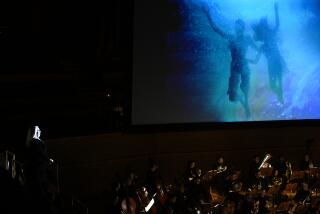REVIEW : Hockney Finds an Odd Angle for ‘Tristan’
It would be stirring to report that David Hockney’s much-talked-about sets and costumes for “Tristan und Isolde” had altered the course of art history or caused the audience to riot in protest the way Pablo Picasso’s sets for Sergei Diaghilev did back in the great old days, but the times they have a-changed.
In this neo-conservative epoch, the significance of a collaboration between the creative and the performing arts is to prove that a visual artist can adapt to the exigencies of tradition and convention--fit in and be a regular guy rather than some outrageous egomaniac. Creative, you know, but not too creative.
Hockney--who’s had some practice doing opera--served art and spectacle equally. His sets for Richard Wagner’s classic tragedy of love and death turned every trick in the deck to make themselves look as pictorial as tableaux for the Laguna Pageant of the Masters.
The opera opens on board a sailing ship, moves to a road between a castle and a wood and winds up with everyone dying at great length on a cliff over the ocean in Cornwall. For each scene Hockney employed a floor so sharply angled it seemed to affect the movement of singers. Isolde (Jeannine Altmeyer) had some formidably heavy dresses to lug about and seemed to alternate between lurching and tippy-toeing to maintain balance. In the third act, it was not quite clear whether Tristan (William Johns) was clinging to life or to the floor for fear of rolling off.
Anyway, raked stages make it possible to use exaggerated perspectives, which Hockney exploited fully, especially in the second act where a castle wall and a row of trees plummet into the distance like a disappearing freight train. The effect of combined raking and plummeting is to create the illusion of a flat surface. Hockney’s sets were literally as pretty as pictures--full of his characteristic shorthand shapes for sails and trees, lit front, back and sideways to dramatize the artists pictorial hallmarks. In the third act there were at least three puzzling and abrupt light changes that seemed to have no reason to happen except to create a nice Hockney picture. The production is enormously diverting to behold.
Hockney is known as a witty, cosmopolitan, intensely perceptive stylized realist. If those are not quite the right qualities to bring to Wagner’s Teutonic intensity, that is not the artist’s fault: He did his best to adapt. Hockney is by no means flip in this design but he combines Expressionism with good manners so as to lend “Tristan und Isolde” the character of a fashionable surrealist fairy tale. We thought Wagner was several fathoms deeper than that.
More to Read
The biggest entertainment stories
Get our big stories about Hollywood, film, television, music, arts, culture and more right in your inbox as soon as they publish.
You may occasionally receive promotional content from the Los Angeles Times.










